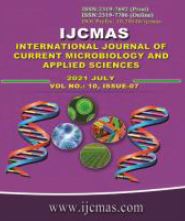


 National Academy of Agricultural Sciences (NAAS)
National Academy of Agricultural Sciences (NAAS)

|
PRINT ISSN : 2319-7692
Online ISSN : 2319-7706 Issues : 12 per year Publisher : Excellent Publishers Email : editorijcmas@gmail.com / submit@ijcmas.com Editor-in-chief: Dr.M.Prakash Index Copernicus ICV 2018: 95.39 NAAS RATING 2020: 5.38 |
Today, in the present-day scenario CoNS, as typical opportunistic infections, represent one of the significant nosocomial pathogens, having a huge impact on human health and life. It is very difficult to determine whether positivity is due to bacteremia or contamination. Hence, the present study is done to determine the Coagulase-Negative Staphylococci (CoNS) positivity in Invasive bloodstream infections using Automated Bactec systems. All the blood culture samples received in the Department of Microbiology for culture by Bactec Bd fx from July 2015 to June 2016 were included in the study. The blood culture was observed in the Bactec Bd fx system for at least 5 days before they are reported as sterile. Among the total 1275 cultures which were positive for bacteria, 344(26.98%) were of Gram-positive bacteria while 931(73.02%) were positive for Gram-negative bacteria. Among the total of 344 culture positive for Gram-positive bacteria, CoNS was isolated in 143 (41.57%) cultures. Among the total, maximum CoNS were found in the age group of 0-1 years (35.66%) followed by the 19-45 year age group (20.98%). All the Coagulase-negative Staphylococcus (CoNS) isolates showed 100% sensitivity to Vancomycin, Gentamycin, Teicoplanin, and Linezolid. Besides, that 91.67% of isolates were sensitive to Levofloxacin, 87.5% Tetracycline, 80%Aztreonam, and 72% to Piperacillin. It was found that Coagulase-negative Staphylococcus (CoNS) showed high-level resistance to Penicillin (53.85%), Ceftazidime (52.00%) Clindamycin (47.01%), and Cotrimoxazole (41.96%). CoNS was one of the most common organisms among GPC isolates and the commonest isolated in the neonate and infant age group. All the CoNS isolates showed maximum sensitivity to Vancomycin, Gentamycin, Teicoplanin, and Linezolid while it showed high-level resistance to Penicillin, Ceftazidime, Clindamycin, and Cotrimoxazole. Strict aseptic procedures to be implemented during patient's stay in the hospital to minimize nosocomial infections.
 |
 |
 |
 |
 |